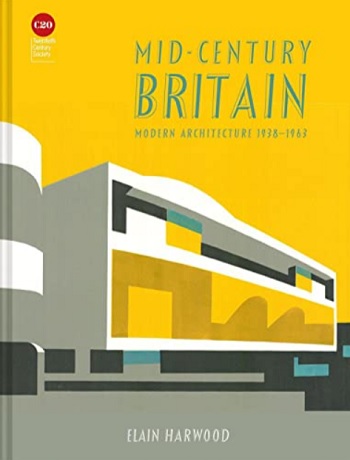Mid-Century Britain: modern architecture 1938-1963
Mid-Century Britain: modern architecture 1938-1963, Elain Harwood, Batsford, 2021, 288 pages, 145 colour illustrations, hardback.
As historian and listing inspector for Historic England (and formerly English Heritage) over many years, Elain Harwood has been instrumental in raising the appreciation of post-war British architecture, notably in an ever-growing series of books. The term ‘Mid-Century Modern’ that she uses for the period 1938-63, originated in the USA, where it was adopted to describe the flashy North Shore hotels in Miami of the 40s and 50s. When adopted in Britain, she tells us, its meaning was somewhat different, with architects typically pursuing a gentler type of modernism which embraced functionalism but did not exclude the decorative touch. The Festival of Britain, held in the summer of 1951, best captures its stylistic ethos, and within the book Harwood traces its development over the next decade as it became simpler and more refined.
In the introduction she explains the influence that continental architects such as Walter Gropius and Marcel Breuer had on British design, identifying the former’s Impington School of 1939 as how British architecture might have evolved but for the second world war. When the war was over, an acute shortage of building materials, not to mention funding, delayed construction and encouraged experimentation such as prefabrication and system building. The gradual revival of the British economy in the 1950s brought greater activity, as well as major public works and advances in technology. Among these were the curtain wall and lightweight concrete shell structures. Midcentury modern, she claims, came to an end with the rise of brutalism.
Following the introduction, most of the book consists of a gazetteer of buildings, each given a full-page illustration and a brief description. It is divided into building categories, beginning appropriately with the Festival of Britain. Other categories include private houses, low-cost housing, education, public buildings, transport and places of worship. Many of the selected buildings are not well-known (among them is this reviewer’s house), and about one third are unlisted. The handsome photographs are almost all taken by the author, and the book is attractively designed. While the format allows limited scope for detailed analysis of the buildings (and no plans), the book skilfully evokes the spirit of the two decades it covers. It is a bargain at £25.
This article originally appeared as ‘A gentler modernism’ in the Institute of Historic Building Conservation’s (IHBC’s) Context 175, published in March 2023. It was written by Peter de Figueiredo, reviews editor of Context.
--Institute of Historic Building Conservation
Related articles on Designing Buildings
- Brutalism.
- Conservation.
- Demolishing Modernism: Britain's lost post-war gems.
- Heritage.
- Historic environment.
- IHBC articles.
- Institute of Historic Building Conservation.
- Listed buildings.
- Modern building.
- Modernism.
- Modernist Architecture: international concepts come to Britain.
- Postmodern architecture.
IHBC NewsBlog
Old Sarum fire in listed (& disputed) WW1 Hangar - Wiltshire Council has sought legal advice after fire engulfed a listed First World War hangar that was embroiled in a lengthy planning dispute.
UK Antarctic Heritage Trust launches ‘Virtual Visit’ website area
The Trust calls on people to 'Immerse yourself in our heritage – Making Antarctica Accessible'
Southend Council pledge to force Kursaal owners to maintain building
The Council has pledged to use ‘every tool in the toolbox’ if urgent repairs are not carried out.
HE’s Research Magazine publishes a major study of the heritage of England’s suburbs
The article traces the long evolution of an internal programme to research 200 years of suburban growth
IHBC Context 183 Wellbeing and Heritage published
The issue explores issues at the intersection of heritage and wellbeing.
SAVE celebrates 50 years of campaigning 1975-2025
SAVE Britain’s Heritage has announced events across the country to celebrate bringing new life to remarkable buildings.
IHBC Annual School 2025 - Shrewsbury 12-14 June
Themed Heritage in Context – Value: Plan: Change, join in-person or online.
200th Anniversary Celebration of the Modern Railway Planned
The Stockton & Darlington Railway opened on September 27, 1825.
Competence Framework Launched for Sustainability in the Built Environment
The Construction Industry Council (CIC) and the Edge have jointly published the framework.
Historic England Launches Wellbeing Strategy for Heritage
Whether through visiting, volunteering, learning or creative practice, engaging with heritage can strengthen confidence, resilience, hope and social connections.
















Comments
[edit] To make a comment about this article, click 'Add a comment' above. Separate your comments from any existing comments by inserting a horizontal line.